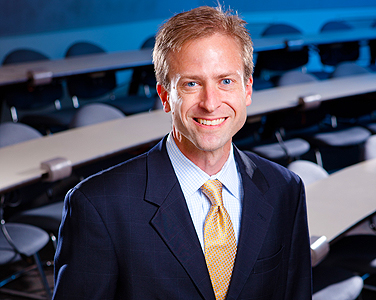Close Up
Developing leadership
Tesluk helps organizations successfully navigate change

New School of Management faculty member Paul Tesluk says growing up in Buffalo helped him choose his career path. Photo: DOUGLAS LEVERE
-
 Print
Print -
 Comments
Comments
-
“A lot of the work that I do in the areas of leadership development and organizational effectiveness, transformation and change is helping organizations be more competitive and successful, and to spur innovation.”
Paul Tesluk’s arrival in UB’s School of Management last July was a homecoming. He established himself as one of the nation’s leading scholars of organizational behavior during 12 years on the faculty of the Robert H. Smith School of Business at the University of Maryland. Now, an opportunity brought him back to the place where he was born and raised and found his calling.
“I think a lot of the reason that I chose the career path that I did was motivated by my experiences growing up here, particularly during the time that the Western New York economy was in such a downward death spiral, and organizations and talent were leaving the area in abundance,” relates the Donald S. Carmichael Professor of Organizational Behavior.
“A lot of the work that I do in the areas of leadership development and organizational effectiveness, transformation and change is helping organizations be more competitive and successful, and to spur innovation. The opportunity to be able to do what I do in research, and to practice in the community where I grew up, will hopefully contribute to some of the ongoing efforts here.”
Tesluk is excited by the opportunities that the area presents and appreciative of the reception he has received in the school and the university, with an emphasis on collaboration. He is teaching leadership development and beginning to work with organizations in the community; one thrust of this work is in the health care field.
“Through working with providers and other larger players in the health care area, particularly on the insurer’s side, the whole business model is now changing,” he observes. “It’s one that used to be likened to kind of a public utility, processing claims as efficiently as possible. Now, in many cases, it’s providing benefits directly to individuals rather than through their employers.
“Another shift we see is insurers trying to promote wellness and health. There is a tremendous amount of change and transformation in all of that. Certain jobs are going to have to be built and created, and other types of jobs are probably going away,” he says. “At the same time, you need some of those critical skill sets and competencies as you transform from one set of platforms and strategies to another. The change is incredibly complex. That’s one area where we can help manage that change effort and do that in a way that enables the organization to be successful.”
Tesluk also is involved in conversations with various people within the UB medical school regarding the development of health care professionals, both in terms of the administrative side, as well as practicing physicians and health care professionals who work in teams.
“Health care is now much more interdisciplinary and delivered in a much more customer-focused framework,” he points out. “That’s a whole different set of skills above and beyond the kind of core medical and health care set of skills that practicing health care professionals—whether they’re on the administrative side or on the actual delivery of health care side—need to master.”
Tesluk cites the new forms of surgery, such as minimally invasive surgical techniques, that require a much more coordinated, interdisciplinary, interdependent environment.
“That requires different forms of teamwork and collaboration,” he says. “That’s another area where we can be helpful in working with our colleagues in the medical school and other health care professions from a training and development standpoint. We’re exploring ways to do that.”
Much of Tesluk’s work bridges leadership development and organizational change. “We often find that one of the pressure points in organizational change is leadership capacity—often in the mid- and front-line levels—to help employees manage transformational and organizational change. Any time that an organization goes through dramatic change, there is ambiguity, which calls for direction and clarity. There are emotions associated with feelings of anxiety and lack of understanding. Those are all things that leaders need to do to be able to interpret the strategy and direction the organization is taking for the people who are actually doing the work.”
Team effectiveness is another research focus for Tesluk, who is in the second year of a multi-year study supported by the National Science Foundation that looks at how internal leadership develops in the form of shared leadership among distributed teams. He is in the process of partnering with some area companies—where innovation is a critical part of their growth—to see the effect of phenomena in experimentally controlled environments, as well as in real-world settings.
While at the University of Maryland, Tesluk co-founded the Center for Leadership, Innovation and Change, which bridged research and practice by assisting organizations with their innovation and change challenges by applying learning from leading-edge research. He sees the potential benefits to both the Western New York and Buffalo business communities and research on leadership with a similar center here at UB.
Meanwhile, Tesluk is commuting weekly between his home near his former university and his new home near Delaware Park in Buffalo where his wife—also a Buffalo native—and children will be joining him after the school year ends.
That will complete the homecoming and spur his determination to help contribute to the success of the community where he found his inspiration.

Reader Comments